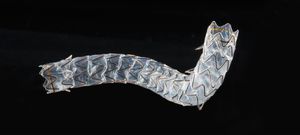
Biliary stent graft GORE® VIATORR® TIPSePTFE

Add to favorites
Compare this product
Characteristics
- Type
- biliary
- Material
- ePTFE
- Diameter
8 mm, 9 mm, 10 mm
(0.315 in, 0.354 in, 0.394 in)
Description
For patients with portal hypertension, including those with variceal bleeding and refractory ascites, the GORE® VIATORR® TIPS Endoprosthesis has been improving patient outcomes for more than 20 years. The VIATORR® Device has proven patency1 and patients treated with the VIATORR® Device have a higher one-year survival than those treated with non-TIPS therapy.
Purpose-built for TIPS
Controlled expansion sleeve is designed to provide intraoperative adjustability of the diameter between 8 mm and 10 mm.*
Designed to reach a targeted portal pressure gradient to meet the specific needs of the patient.
Lasting diameter control. Size and set the diameter to stay.*
Bile-resistant, ePTFE lining designed to sustain patency due to reduced in-stent stenosis.
Uncovered portion for sustained portal vein and shunt perfusion.
Optimized radial force and flexibility engineered for conformability in tortuous anatomy.
Covered stent grafts offer long-term patency, compared to bare metal stents
Studies reveal that, at the time of TIPS creation, ePTFE-covered stent grafts have shown improved patency, ascites control and rebleeding prevention, compared to bare metal stents.
For patients undergoing TIPS placement, the Advancing Liver Therapeutic Approaches (ALTA) group recommends, "The use of an ePTFE-lined stent graft with controlled expansion, which allows the operator to tailor the amount of portosystemic shunting based on the indication, target gradient and patient comorbidities."
Variceal bleeding outcomes
Early TIPS compared to drug therapy plus endoscopic band litigation (EBL) for variceal bleeding13
VIDEO
Catalogs
No catalogs are available for this product.
See all of Gore‘s catalogsRelated Searches
- Vascular introducer
- Stent graft
- Polymer stent graft
- Metal stent graft
- Hydrophilic access sheath
- Synthetic tissue matrix
- Synthetic vascular prosthesis
- Vascular prosthesis
- EPTFE stent graft
- Abdominal aorta stent graft
- Cardiac tissue matrix
- Vascular tissue matrix
- Occlusion device
- Artery vascular prosthesis
- EPTFE vascular prosthesis
- Embolic protection system
- Abdominal aorta vascular prosthesis
- Carotid embolic protection system
- Peripheral stent graft
- Two-branch vascular prosthesis
*Prices are pre-tax. They exclude delivery charges and customs duties and do not include additional charges for installation or activation options. Prices are indicative only and may vary by country, with changes to the cost of raw materials and exchange rates.


